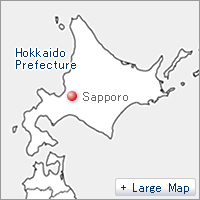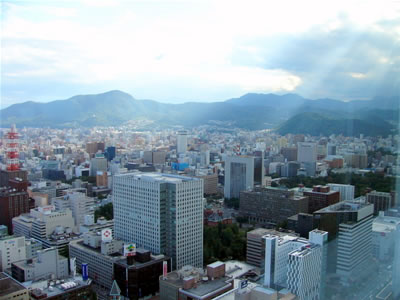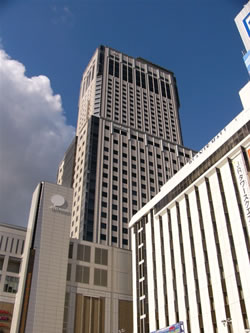(1) Location & Access

- The most common method of reaching Hokkaido is by air. The flight takes approximately 1 hour and 30 minutes from Tokyo and 1 hour and 55 minutes from Osaka.
(2) Overview
Sapporo is the center of politics, economy and culture in Hokkaido. In 1869, the Meiji government established the Hokkaido Development Bureau and started developing the town. Blessed with the opportunity to host the Sapporo Winter Olympic Games in 1972, the city underwent extensive refurbishment of its transportation infrastructure with the opening of underground shopping malls and new subway lines, which in turn fostered a prosperous travel industry. Many tourists visit Hokkaido for its cool summer climate and grand nature and enter the island from Sapporo. In recent years, Hokkaido has gained a reputation for the quality of its snow and the number of skiers visiting from overseas, mainly from Australia, is increasing.

The economy of Sapporo reflects the economy of Hokkaido, mixing both positive and negative aspects. In addition to the deterioration of suburban towns shadowed by the decline of the mining and fishing industries, a major local bank collapsed due to excessive lending to resort facilities in 1997. Since then, the Hokkaido economy has begun to gradually recover, but its progress still lags behind other regions. While populations in rural areas continue to decrease, the population of Sapporo has been rising with the influx of people into the area and saw an increase of 3.2% over the period between 2000 and 2005. In Sapporo, the ratio of manufacturing businesses is lower compared to other cities in Hokkaido and the ratios of wholesale and retail businesses and food and service industries are higher in comparison.
A built-up urban area spreads out on the south side of JR Sapporo Station and is divided by the cruciform pattern of Ekimae-dori Street extending from the front of the station and Odori Park stretching out narrowly to the east and west. The government office and business districts can be found along Ekimae-dori Street, which extends from JR Sapporo Station to Odori Park. The area south of Odori Park forms a busy commercial district, which is called Susukino. The Nanboku (south-north) subway line, which runs underneath Ekimae-dori Street and the Tozai (east-west) subway line, which runs underneath Odori Park, intersect each other at the Odori subway station.

JR Tower Sapporo
Along with the surge of people moving in from other areas of Hokkaido, the vacancy rate for office buildings is decreasing and the rent standard is improving. Housing investment is also improving. Although plans for constructing new office buildings were being held back, buildings of an unprecedented scale have been completed over the past several years, including the JR Tower in 2003, the Nihon Seimei Sapporo Building and the 8-3 Square Kita Building in 2006. With increasing demand for call centers and office relocation, these buildings had satisfactory tenancy contract rates by the time of completion.
In 2008, two more large buildings will be completed. Several plans to redevelop or rebuild in the neighborhood of Sapporo Station and areas alongside Odori Park are currently underway. The project for an underground pedestrian passage to connect the surrounding areas of Sapporo Station and the Odori area will be completed in 2010, which will improve traffic convenience during the snow season. Construction of a super-high-speed bullet train line connecting Sapporo and Tokyo and passing under the Tsugaru Strait has already commenced. The central area of Sapporo will also undergo further transformation in the mid- to long-term.
(3) Profile Data
1. Major office buildings: year completed, major owner
JR Tower Office Plaza Sapporo: February 2003, Hokkaido Railway
Sapporo L-Plaza: March 2003, Nippon Building Fund
Urbannet Sapporo Building: October 2004, NTT Urban Development
Nippon Life Insurance Sapporo building: September 2006, Nippon Life Insurance
2. Major companies headquartered in Sapporo City
Hokkaido Electric Power, Hokkaido Gus, Hokkaido Railway, North Pacific Bank



